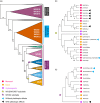Unlocking regeneration potential: harnessing morphogenic regulators and small peptides for enhanced plant engineering
- PMID: 39658544
- PMCID: PMC11771577
- DOI: 10.1111/tpj.17193
Unlocking regeneration potential: harnessing morphogenic regulators and small peptides for enhanced plant engineering
Abstract
Plant genetic transformation is essential for understanding gene functions and developing improved crop varieties. Traditional methods, often genotype-dependent, are limited by plants' recalcitrance to gene delivery and low regeneration capacity. To overcome these limitations, new approaches have emerged that greatly improve efficiency and genotype flexibility. This review summarizes key strategies recently developed for plant transformation, focusing on groundbreaking technologies enhancing explant- and genotype flexibility. It covers the use of morphogenic regulators (MRs), stem cell-based methods, and in planta transformation methods. MRs, such as maize Babyboom (BBM) with Wuschel2 (WUS2), and GROWTH-REGULATING FACTORs (GRFs) with their cofactors GRF-interacting factors (GIFs), offer great potential for transforming many monocot species, including major cereal crops. Optimizing BBM/WUS2 expression cassettes has further enabled successful transformation and gene editing using seedling leaves as starting material. This technology lowers the barriers for academic laboratories to adopt monocot transformation systems. For dicot plants, tissue culture-free or in planta transformation methods, with or without the use of MRs, are emerging as more genotype-flexible alternatives to traditional tissue culture-based transformation systems. Additionally, the discovery of the local wound signal peptide Regeneration Factor 1 (REF1) has been shown to enhance transformation efficiency by activating wound-induced regeneration pathways in both monocot and dicot plants. Future research may combine these advances to develop truly genotype-independent transformation methods.
Keywords: Agrobacterium rhizogenes; Agrobacterium tumefaciens; biolistic bombardment; cut‐dip‐budding; genotype‐flexible transformation; in planta transformation; leaf transformation; somatic embryogenesis; tissue culture‐free transformation.
© 2024 The Author(s). The Plant Journal published by Society for Experimental Biology and John Wiley & Sons Ltd.
Conflict of interest statement
The authors declare that they have no conflict of interests associated with this work.
Figures

Similar articles
-
Selectable marker independent transformation of recalcitrant maize inbred B73 and sorghum P898012 mediated by morphogenic regulators BABY BOOM and WUSCHEL2.Plant Cell Rep. 2017 Sep;36(9):1477-1491. doi: 10.1007/s00299-017-2169-1. Epub 2017 Jul 5. Plant Cell Rep. 2017. PMID: 28681159 Free PMC article.
-
Maize Transformation Using the Morphogenic Genes Baby Boom and Wuschel2.Methods Mol Biol. 2019;1864:81-93. doi: 10.1007/978-1-4939-8778-8_6. Methods Mol Biol. 2019. PMID: 30415330
-
Morphogenic Regulator-Mediated Transformation of Maize Inbred B73.Curr Protoc Plant Biol. 2018 Dec;3(4):e20075. doi: 10.1002/cppb.20075. Epub 2018 Oct 22. Curr Protoc Plant Biol. 2018. PMID: 30369097
-
Strategies for genotype-flexible plant transformation.Curr Opin Biotechnol. 2023 Feb;79:102848. doi: 10.1016/j.copbio.2022.102848. Epub 2022 Dec 1. Curr Opin Biotechnol. 2023. PMID: 36463838 Review.
-
Technological Development and Application of Plant Genetic Transformation.Int J Mol Sci. 2023 Jun 26;24(13):10646. doi: 10.3390/ijms241310646. Int J Mol Sci. 2023. PMID: 37445824 Free PMC article. Review.
Cited by
-
Strategies to develop climate-resilient chili peppers: transcription factor optimization through genome editing.Planta. 2025 Jun 17;262(2):30. doi: 10.1007/s00425-025-04747-5. Planta. 2025. PMID: 40526281 Free PMC article. Review.
-
Non-tissue culture genetic modifications for plant improvement.Plant Mol Biol. 2025 May 16;115(3):67. doi: 10.1007/s11103-025-01594-6. Plant Mol Biol. 2025. PMID: 40377725 Review.
-
Through the lens of bioenergy crops: advances, bottlenecks, and promises of plant engineering.Plant J. 2025 Jul;123(2):e70294. doi: 10.1111/tpj.70294. Plant J. 2025. PMID: 40674648 Free PMC article. Review.
-
Plant engineering: advances, bottlenecks, and promise.Plant J. 2025 Apr;122(2):e70117. doi: 10.1111/tpj.70117. Plant J. 2025. PMID: 40275776
References
-
- Aesaert, S. , Impens, L. , Coussens, G. , Van Lerberge, E. , Vanderhaeghen, R. , Desmet, L. et al. (2022) Optimized transformation and gene editing of the B104 public maize inbred by improved tissue culture and use of morphogenic regulators. Frontiers in Plant Science, 13, 883847. Available from: 10.3389/fpls.2022.883847 - DOI - PMC - PubMed
-
- Aliu, E. , Ji, Q. , Wlazlo, A. , Grosic, S. , Azanu, M.K. , Wang, K. et al. (2024) Enhancing Agrobacterium‐mediated plant transformation efficiency through improved ternary vector systems and auxotrophic strains. Frontiers in Plant Science, 15, 1429353. Available from: 10.3389/fpls.2024.1429353 - DOI - PMC - PubMed
Publication types
MeSH terms
Substances
Grants and funding
LinkOut - more resources
Full Text Sources
Research Materials
Miscellaneous

